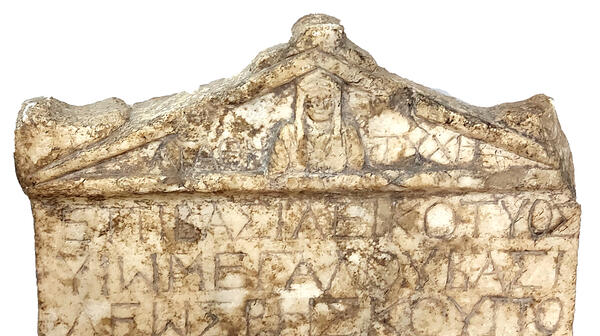In Tanais, like in other Greek cities, wealthy merchants used some of their money to support urban improvements. Texts on stone slabs often mention citizens repairing market squares, gates, or defensive towers at their own expense. This type of monument is represented by the Chophrasmus Slab from the Tanais Archaeological Museum-Reserve.
The Chophrasmus Slab is a tall, thin, rectangular marble slab, carefully polished, slightly flaring at the bottom. It is crowned with a pediment, with an image in high relief depicting a woman — presumably a goddess — and an inscription. The pediment is decorated with a protruding bead and almost triangular projections along its edges. The entire surface of the slab is covered with a Greek text, consisting of 21 lines. The letters are large. The long inscription starts with the traditional greeting, “Agathe Tyche!” meaning “Good Fortune!” Mainly, the text refers to a donation by the citizen Chophrasmus, son of Phorgabacus, who provided funds for the repair of gates and restoration of walls of Demetrius. This happened during the reign of King Cotys, son of the great king Rhescuporis, which is indicated in the first line. As was customary at that time, all inscriptions started with the title of kings of Bosporus, the territory which included Tanais.
The stele features an image of a female bust,
presumably a deity, wearing a calathus and a chiton with a V-neck. The goddess
is depicted looking straight ahead, with a calathus on her head and a veil
draped over her shoulders. Dmitry Borisovich Shelov believed that the image on
the pediment was of the goddess Aphrodite Apaturia, or Aphrodite the Deceitful.
This epithet was given to the goddess in the myth of Heracles. She lured the
giants into a cavern and surrendered them to Heracles to kill them. In the
early centuries of the common era, the cult of this great goddess was widely
spread. It was associated with the natural forces, identified by the Greeks
with Aphrodite. It merged into a single cult known as Aphrodite Apaturia or
Aphrodite Urania. In Tanais, this cult was also widespread as evidenced by
other archaeological findings.



